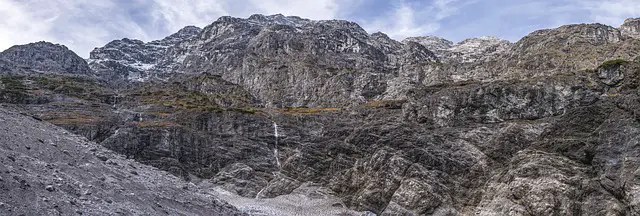We have a lot of beneficial self-help guides, which has complete practical information on how to attain a lot of both personal and professional objectives. This is something a bit different. As a matter of fact, it’s a lot more like the opposite.
In these chapters, you’ll learn how to do things you didn’t desire to do in methods you’d never like to attempt. Also, you’ll learn absolutely impractical solutions to day-day issues founded on real math, science, and history.
What does this mean? Well, part of it only to laugh. However, these chapters will enable you to view the world from a different point of view. Through Randall Munroe’s zany perspective, you’ll also get to see part of the equally zany likelihoods concealed inside the real laws and properties of the universe.

1 – By being slow and steady, you will eventually succeed when crashing an airplane.
This is the question that the majority of self-help guides are unable to answer: When you’re flying a small airplane across the countryside and it unexpectedly breakdowns, where do you have to crash land it?
Your best stake is a newly planted farm field. Cornfields are good until the middle of June. You don’t have to make the crops very thick and tall since then they might turn the plane over. For example, the sunflowers field is not a good idea. Then again, you can target a cow pasture. But, ensure that you don’t bump into any cows. Well, also attempt not to have your airplane breakdown on a rainy day. You wouldn’t want to land in the mud.
In a pinch, land above a train or a flatbed truck. Only reduce the speed of your airplane so that it fits with the speed of the vehicle, afterward, gradually touch down on top of it. Note that a train or a truck is constantly bumping up and down a bit as it moves. Therefore, be cautious not to bounce off while landing. Besides that small problem, this is an absolutely practical technique. Air show pilots do this, therefore, there’s no cause why you can’t do it as well.

However, what if you’re flying over the sea? In such instances, you can use a similar method with an aircraft carrier, or a surfaced submarine. Tell the captain to steer his ship a quick as he can into the wind. This would provide headwinds of about 60 miles per hour to fly against as you get close to the ship. This will slow you down, allowing you to land on a short surface.
In order to ensure that your plane is even slower while you land, you’ll have to turn off the throttle and put away your wing flaps –however, ensure that you retract them the instant you land. If not, the wind could blow your plane off the ship. Furthermore, ensure that you keep your hand on the throttle and be prepared to push it forward to take off again, just so you mess up.
Nevertheless, it’s better to be safe than sorry, and you can continually keep trying.
2 – If there is no water pipeline, it will be tough to fill a swimming pool with water; however, it is possible.
Having crash-landing an airplane well, you’ll most likely want to celebrate and relax. What is the best manner to do that than a pool party? However, firstly, you require a pool for this.
Luckily, building an in-ground pool is really simple. You only have to dig a large hole in the ground and line it with plastic to ensure that your pool doesn’t become a muddy pond. Afterward, all that is left to do is to fill it with water. If you need it to be very big to fit a diving board, you’ll need nearly 20,000 gallons of water.
However, what if you don’t possess a water pipeline? There are a few different approaches to have 20,000 gallons of water. For instance, you could order for 150,000 bottles of Fiji water from Amazon. That is nearly $25 for each 24-pack, these will cost you a bit more than $1 per bottle. Plus nearly $100,000 for the same day delivery and you’ll require about a quarter of a million dollars to do this.
But, each bottle cap will need a minimum of a couple of seconds to open them, and there are just 86,400 seconds in a day. Therefore, if you need to have your pool party that same day, you’ll need a faster approach to opening them.
You are probably considering, “Can’t I just blow the bottles off with an explosive device?” Back then, during the year 1955, the US government truly tested nuclear weapons on beverage bottles in Nevada. Their aim was to check how emergency supplies would survive in the incident of an atomic war. Remarkably, the majority of the bottles endured the explosions.

The tests took place back then in the 1950s, and plastic wasn’t a popular material then. Therefore, the bottles were made from glass and metal. However, the outcomes recommend that there are better methods to open bottles, irrespective of what they’re made of.
The best approach to do this would be to make use of an industrial plastic shredder, such as Brentwood AZ15WL 15kW. These are the things recycling centers use to rip up bottles, and they can process 30 tons of plastic and liquid each hour. At that rate, you would need only a bit over two hours to fill your pool.
Industrial shredders usually have a price of five or six figures –however, you might get a discount if you decide that the alternative is a nuclear bomb.
3 – Digging a massive hole in the ground is easy on the condition that you have the accurate tools.
Now that you understand how to fill your in-ground swimming pool with 150,000 bottles of Fiji water, all you have to do now is to begin digging a hole. That takes us to our next question. How do you dig a gigantic hole?
Well, the easiest method is to use a shovel. Depending on the kind of ground you’re attempting to dig, you’ll be able to take out almost 0.3 to 1 cubic meters of dirt each hour with this standard digging tool. After 12 hours of strenuous labor, you’ll most likely have dug a hole that’s as deep enough for you to stand in it up to shoulder level, and wide enough for you to lie down in.
Luckily, you can increase things up by a factor of 10 or more than by making use of a vacuum excavator. This is precisely what it sounds like – a massive vacuum cleaner that draws up dirt. However, it also has another significant aspect– a high-power jet of water or air that explodes through firmly packed soil, converting it into pieces that are small enough to be suctioned up.
But, if you truly want to take your digging power to the next stage, you should make use of a mining excavator. The main thing here is to get rid of one layer of earth at a time, starting each new layer a bit nearer to the middle of your hole than the previous one. From the side view, if you could see a cross-section of your hole, it would appear like an upside-down layer cake.

That’s how huge open-pit mines are made, like the central pit of the Bingham Canyon copper mine in Utah. That hole is over half a mile deep and two miles wide.
Those dimensions might be too much for a swimming pool; however, there are other practical applications for your newly learned industrial excavation methods. For instance, let’s assume that you want to look for some buried pirate treasure. Legend said some can be found underneath Oak Island in Nova Scotia. The island is not more than a mile wide at its widest point –very smaller than the central pit of Bingham Canyon. Provided that you create a sea wall, you could dig up the whole island, down past its bedrock.
Then, just examine through the dug-up dirt. If the treasure is truly present, you’ll be certain to see it.
4 – Making a solid lava moat is essentially about appropriate heat management.
You’ll most likely like to improve your lifestyle with your entire newfound pirate treasure. However, that will make your house be a target for thieves. In order for you to stay protected, you might need to dig a moat. Better still, what about a lava moat?
You are aware of how to dig; therefore let’s concentrate on making lava. The only thing you require is some rocks and heat. That depends on the rocks you use, you’ll have to warm them up to a minimum of 800 degrees celsius to allow them to melt. And if you need your lava to glow bright orange in the daytime, you’ll need to increase the temperature to 1,000 degrees. Let’s separated the difference and target a simple 900 degrees.
Now, the instant you free your lava into the moat, it’s going to begin cooling down and ultimately become a solid rock back. Therefore, you have to ensure that it is nice and toasty with a regular supply of heat. In order to do this, you will have to install a heating device beneath your moat. An electric coil can be suitable. Ensure to keep it insulated.
At 900 degrees, your lava will emit heat at a rate equal to approximately 100 kilowatts of energy each square meter. You’ll have to make use of an equivalent amount of energy to make up the difference and ensure that the lava remains heated. Let’s say, for instance, electricity costs $0.10 per kilowatt-hour, this will cost you $10 each hour per square meter of lava. If your moat is just a meter wide and covers only one-acre property, that is nearly $60,000 each day.

You might be wondering now, “This is ridiculous – one meter wide is really small.” However, do not bother. The air around the lava will be really hot that a person attempting to jump over it would have second-degree burns in under a second.
However, unless you’re cautious, the heat will also keep your home very warm to live in. Luckily, if you live close to a cold body of water, you can fix this issue by taking advantage of water’s massive heat storage ability. Pump the water through the walls of your house to take the heat away.
As a matter of fact, that is the approach Google uses to cool down one of their data centers on the coast of Finland – hence, why not do the same as google?
5 – With sufficient creativity and initiative, you can produce electricity on Mars without the use of Earth-derived energy sources.
Definitely, you could only sit back and relax in your Fiji water-filled swimming pool, enjoying an extravagant, and pirate treasure-funded lifestyle in the care of your lava moat. However, if you have gone this far, you’re likely an adventurous person who wants to see new environments and try out new things.
That takes us to our next activity– living off the grid on Mars.
Let’s assume that you have gotten to the Red Planet and created a nice little Martian homestead for yourself. How can you power it? Definitely, you could just take along with you an energy source from Earth; however, that would be cheating. If you truly want to live off-grid, you have to generate power by making use of on-site resources. However, that’s going to cancel out the majority of the energy sources you could take on Earth.
Hydropower? There are no rivers. Nuclear power? There is no uranium. Fossil fuels? There are no fossils. Geothermal power? Unfeasible – there’s not enough geologic activity. Solar power? Ineffective as well – the sun is really far away.
What of wind power? Well, usually, the Martian atmosphere is really thin and slow-moving even to turn a wind turbine blade –however, there is a method to get around that. It comprises of three easy steps.
Firstly, attach a 5,820 kilometer-long tether to Phobos, Mars’s nearest moon. You need to run the tether between the moon and the planet, allowing it dangle into the Martian atmosphere. Due to Phobos’s orbital speed, the tether will fly through the atmosphere at 530 meters each second. With that speed, the wind moving past your tether will be holding the estimate of nearly 150 kilowatts of energy per square meter. Back on Earth, the typical US home makes use of about 1 kilowatt every year. Therefore, if you can only tap into a part of that wind energy, you’re ready.

That takes us to step two. Tie a wind turbine to the tether. This is where you could simply go wrong. You don’t have to make use of an average wind turbine. They aren’t intended to work at supersonic speeds. However, there are supersonic turbines that are used on high-speed aircraft and rockets. Therefore, ensure that you make use of one of those.
Lastly, you only have to transfer the energy from the turbine to your house. You could transfer it with a microwave beam or reduce it in a lot of rechargeable batteries. It’s your moon-powered supersonic wind turbine, therefore, do anything that works best for you.
6 – If you’re determined, you can travel more than the speed of light – nearly.
Now, you might be feeling prepared for an actual adventure –therefore, why not target the stars? In order to attain them in a practical amount of time, you’ll have to travel faster than the speed of light. Now, frankly speaking, that’s not practical; however, there’s a clever little hack in which you can reach a similar effect.
To start with, you will have to create a spaceship that can frequently accelerate at 1g. Meaning it acquires speed at the exact rate as objects are accelerated downward by Earth’s gravity – roughly 9.8 meters per second. Real-life rockets and roller coasters can accelerate this faster; therefore, it’s absolutely achievable. Faster accelerations are doable; however, they’re really uncomfortable since the human body can’t withstand them. Therefore, for practical reasons, 1g is the boundary at which we can accelerate for long periods.
However, don’t bother– the acceleration rapidly adds up. Beginning from the Earth, you could get to the moon in four hours and Jupiter in just a week.
Now, this is where things begin to get a bit weird. According to relativity theory, the quicker you travel, the slower you experience time relative to the viewpoint of an outside onlooker. Let’s name this your “subjective” time. Conversely, from your point of view, the outside onlooker will be experiencing time faster than you. Let’s name this “external” time. The more and faster you travel, the more the difference between the two experiences of time will increase.
For instance, after accelerating for one subjective year, you’ll be traveling at nearly three-fourths the speed of light –however, you’ll have been speeding through space for 14 months of external time. Due to that, you’ll have finished much more distance than you’d supposed to in only one subjective year.

The more you accelerate, the more “extra” distance you’ll acquire each subjective year. When you have accelerated for two subjective years, you would have traveled above two light-years of distance –as if you’ve moved faster than light! In another subjective year, and you would have traveled almost ten light-years. In the meantime, a bit more than ten years will have gone by in the outside world.
Hence, from an external point of view, you’ll still be going slightly slower than the speed of light, however, from your viewpoint, you’ll be hurtling through space very faster. After doing this for 20 subjective years, you’ll be traveling billions of light-years of distance each subjective year.
When you’ve accelerated for 30 subjective years, the world would have aged by nearly 10 trillion years, and the majority of the stars will be dead –however, consider the entire places you’ll have visited in the meantime!
7 – With a small knowledge of history and science, you can be able to determine when a person was born without asking.
You might be thinking after you have traveled 10 trillion years to the future in only 30 years of subjective time, “How old does that make me you?” That takes us to our next, more practical question. How can you determine the age of a person?
Yes, you could only ask them; however, there are other and more creative approaches you can make use of. As history explains, our world is regularly changing. Some of those changes put last longing marks on our bodies. If you understand what to search for, you can make use of those marks to know when a person was born.
For instance, between the years1945 and 1962, the US and the USSR tested a lot of nuclear weapons. A lot of them were launched in the atmosphere, which emitted contaminants into the wind. Of those contaminants that were released into the wind was a chemical known as strontium-90, which spread through the atmosphere and got into the bodies of the children that were growing up during the early 1960s.
Strontium-90 is very alike to calcium; therefore, those children’s bodies fused it into their teeth and bones. Both our teeth and bones replenish themselves from time to time. But, teeth do this slower than bones. The children’s skeletons ultimately replaced their entire strontium-90 with calcium; however, among those who children who were developing their permanent teeth during that time, small amounts of the chemical are still there up till now. If you discover high levels of strontium-90 in a person’s teeth, you should be aware that you’re dealing with a Baby Boomer.

However, what if you discover high levels of lead in their teeth? Then you could know that you are dealing with either a Baby Boomer or a Gen-Xer. Back then, during their time, people used to drive cars that combusted leaded gasoline, which emitted lead into the air. That led to an outbreak in lead poisoning which started during the mid-twentieth century and was high in 1972, although high levels of contamination remained till the late 1970s.
In order to separate the post-1972 Gen-Xers from their pre-1972 counterparts and the Baby Boomers who came before them, just see if they have any smallpox vaccine marks. In 1949, in the US, the smallpox disease was eradicated, and routine vaccinations against it finished in 1972. The mark left by the vaccine contains a small oval imprint, which you’ll see on the upper arm or outer leg.
8 – Don’t allow the absence of charisma, vision, competency or work ethic hinder you from getting into political office.
If you have done all the things mentioned above from crash-landing an airplane to (kind of) breaking the speed of light barrier, you’re maybe very popular by now. Maybe it’s time to think of a profession in politics. That takes us to our last question. How do you win during an election?
You could do it how you are meant to do it, by canvassing voters to back you up as a candidate. However, that typically needs possessing a likable character, a fascinating vision of the future, a set of political abilities and an enthusiasm to do all the hard work needed in campaigning.
The very simpler other approach is to trick people into voting for you. One approach to do that is to do a change of name. Back then in 2016, for instance, a man from Canada changed his name to “Above Znoneofthe.” Afterward, he contested for a provincial election in Ontario. He guessed that the ballot would put the names of runners in alphabetical order, categorizing them by the last name, and then with the first name.
Hence, “Jane Doe” would be somewhere close to the top of the ballot as “Doe Jane.” At the very end of the ballot, there will be “Znoneofthe Above”, which he anticipated that discontented voters would see as “none of the above.” Unluckily for him, the ballot had names of people listed in alphabetical order using their first name, therefore, he was at the top of the ballot as “Above Znoneofthe” and he didn’t win the election.
If that trick isn’t successful for you too, you could endeavor to relocate to Pennsylvania and making a change of name to Bob Casey. From the 1960s up till now, five different men called Bob Casey has contested for several state and federal offices in Pennsylvania.
This has caused some confusing conditions. In 1976, one Bob Casey was state auditor, and the second Bob Casey was contesting for state treasurer and a third Bob Casey was contesting for congress. Allegations were made continuously that both the second and third Bob Caseys were using the advantage of the name recognition of the first Bob Casey, who was a famous person in Pennsylvanian politics.

Afterward, during the 1978 primary election, the first Bob Casey contested governor, and another Bob Casey contested for lieutenant governor. The first Bob Casey didn’t win the primary, maybe partly due to the reason that voters assumed he was attempting to escape with running for both positions. Again in 1986, he contested for governor; however, this time around he professed himself as “The Real Bob Casey.” He won and worked as governor for eight years.
Two years after his retirement which was in 1998, Bob Casey’s son started a successful career in politics that has sustained to this day. What is his name? Bob Casey Jr.
How To: Absurd Scientific Advice for Common Real-World Problems by Randall Munroe Book Review
There are a lot of unreasonable and inadvisable, however, theoretically possible approaches to doing a lot of activities. You could crash land an airplane on a submarine, use 150,000 bottles of Fiji water to fill up a swimming pool, dig up a whole island looking for a pirate treasure or create a lava-filled moat. Also, you could power an off-grid homestead on Mars by harnessing the energy of a moon, find a way into (kind of) traveling faster than light and utilize your understanding of nuclear weapons testing to know the age of a person. If everything fails, you could constantly contest for political office by doing a change of name to Above Znoneofthe or Bob Casey.
Be on the lookout for Phobos.
There’s a bit of information we didn’t say about operating your Martian homestead by adding a tether to Phobos. Okay, it’s like an important thing. Different from our moon’s orbit, which is gradually moving further and further away from Earth, Phobos’s orbit is gradually moving nearer and nearer to Mars. Ultimately, it’s going to crash into the planet. The more you add wind turbines to the tether, the quicker this is going to occur, as a result of the increase in drag. Depending on the number of turbines you use, the collision could occur at any moment from now, for a few years to a few millennia. However, this is the good news – Phobos is really smaller than our moon. It’s just the size of the asteroid that wiped out the dinosaurs.
